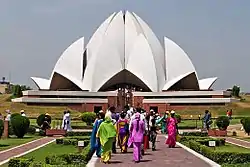Baháʼí Faith and Hinduism
Hinduism is recognized in the Baháʼí Faith as one of nine known religions and its scriptures are regarded as predicting the coming of Baháʼu'lláh (Kalki avatar[1]). Krishna is included in the succession of Manifestations of God. The authenticity of the Hindu scriptures is seen as uncertain.[2] However, Baháʼu'lláh did not explicitly identify himself with Krishna.[3]
| Baháʼí Faith and the unity of religion |
|---|
 |
| Religions |
Scriptural references
Baháʼu'lláh was familiar with Hinduism, which is clear from a tablet to Mírzá Abu'l-Faḍl, the English translation of which is included in the volume Tabernacle of Unity. In this tablet Baháʼu'lláh answered questions about Hinduism and Zoroastrianism by Maneckji Limji Hataria. The subjects include comparative religion, and constitute, while much remains implicit, a dialogue of Baháʼu'lláh with Hinduism and the other religions discussed, giving an understanding of what Baha'u'llah meant with the unity of the world religions.[4]
In another tablet (published in Gleanings, section LXXXVII) Baháʼu'lláh discussed the absence of records about history before Adam. Here he refers to the Jug-Basisht (Book of Juk), which is the Persian translation of the Yoga Vasistha, a syncretic philosophic text.[4] The translation was done during the Mughal Dynasty in the sixteenth century A.D. and became popular in Persia among intellectuals with Indo-Persian interests since then.[5] In the Story of Bhusunda, a chapter of the Yoga Vasistha, a very old sage, Bhusunda, recalls a succession of epochs in the earth's history, as described in Hindu cosmology. Juan Cole states that this means that in dating Creation, Baháʼu'lláh promotes the theory of a long chronology over a short one.[4]
In a letter written on behalf of Shoghi Effendi, published in the Dawn of a New Day, p. 198, it is stated that:
"As regards your study of the Hindu religion. The origins of this and many other religions that abound in India are not quite known to us, and even the Orientalists and the students of religions are not in complete accord about the results of their investigations in that field. The Bahá'í writings also do not refer specifically to any of these forms of religion current in India. So, the Guardian feels it impossible to give you any definite and detailed information on that subject. He would urge you, however, to carry on your studies in that field, although its immensity is well-nigh bewildering, with the view of bringing the Message to the Hindus...."
Teachings
Brahman (God)
In Hinduism Brahman is believed to be the Absolute Reality. Followers of Vedanta see Brahman as an impersonal reality, of which each soul (ātman) is a part. The theistic traditions of Hinduism, which include Vaishnavism and Shaivism, consider Brahman as a personal God, whom they call Bhagwan or Ishvara (Lord).[6] According to the Baháʼí teachings these differing views are all valid, as they represent different points of view looking at the Absolute Reality.[7]
Avatars (Manifestations of God)
Both Hinduism and the Baháʼí Faith teach that God manifests himself at different times and places. These messengers are termed Avatars in Hinduism and Manifestations of God in the Baháʼí teachings.[8] However the difference is that Hinduism teaches that Avatars are God himself in human form and are thus divine while Baháʼí teachings stress that the Manifestations of God are not God but his representatives.
The Manifestations of God are not seen as incarnations of God as God cannot be divided and does not descend to the condition of his creatures, but they are also not seen as ordinary mortals. Instead, the Baháʼí concept of a Manifestation of God emphasizes the simultaneously existing qualities of humanity and divinity. In the station of divinity, they show forth the will, knowledge and attributes of God; in the station of humanity, they show the physical qualities of common man.[9] A common Baháʼí analogy used to explain the relationship between the Manifestation of God and God is that of a perfect mirror. In the analogy, God is likened to the Sun – the source of physical life on earth. The spirit and attributes of God are likened to the rays of the Sun, and the Manifestations of God are likened to perfect mirrors reflecting the rays of the Sun.[10] Thus, the Manifestations of God act as pure mirrors that reflect the attributes of God onto this material world.[9]
Deities and images
In Hinduism many deities, depicted in images and murti (statues), are worshipped. Many Hindus believe that all these deities represent different aspects of the one God, Brahman. The Baháʼí teachings state that in this day, when mankind is reaching the state of maturity, images are not needed anymore to form an idea of God.[11]
Ethical and moral teachings
There are many similarities in the ethical and moral teachings of Hinduism and the Baháʼí Faith. These include subject as contemplation, detachment, faith, love, non-violence, purity, respect for parents, righteousness, self-control, right speech, not stealing, truth, virtue, work as worship.[12]
Adaptation of Baháʼí teachings to Hindu context
The speedy growth of the Indian Baháʼí community since the 1960s was influenced by adapting the Baháʼí teachings for presentation in a clearly Hindu context familiar to the people of the countryside - using principles and language familiar to them:[2][13]
- the presentation of Baháʼu'lláh as the Kalki Avatar who according to the Vishnu Purana will appear at the end of the Kali Yuga for the purpose of reestablishing an era of righteousness;
- emphasizing the figures of Buddha and Krishna as past Manifestations of God or Avatars;
- references to Hindu scriptures such as the Bhagavad Gita;
- the substitution of Sanskrit-based terminology for Arabic and Persian where possible (i.e., Bhagavan Baha for Baháʼu'lláh), and the incorporation in both song (bhajan)[14] and literature of Hindu holy places, hero-figures and poetic images;
- Hindi translations of Baha'i scriptures and prayers that appeared during this period which are so heavily Sanskritized as to make it difficult to recognize their non-Hindu antecedents.
See also
Notes
- Buck, Christopher (1986). A Unique Eschatological Interface: Baha'u'llah and Cross-Cultural Messianism, published in: In Iran: Studies in Babi and Baha'i History vol. 3, ed. Peter Smith, pp. 157-179. Kalimat Press, Los Angeles.
- Smith, Peter (2000). "Indian religions". A concise encyclopedia of the Baháʼí Faith. Oxford: Oneworld Publications. p. 195. ISBN 1-85168-184-1.
- "Lights of Guidance, 1567". Bahaiworks, a library of works about the Bahá’í Faith. Retrieved 2020-11-04.
- Cole, Juan R. I. Baha'u'llah on Hinduism and Zoroastrianism: The Tablet to Mirza Abu'l-Faḍl Concerning the Questions of Manakji Limji Hataria.
- Cole, Juan R.I. "Iranian Culture and South Asia, 1500-1900". in: Keddie, Nikki (ed.). (2002). Iran and the Surrounding World: Interactions in Culture and Cultural Politics. pp. 22-23
- Momen 1990, pp. ix
- Momen 1990, pp. 1–5
- Momen 1990, pp. 5–9
- Cole, Juan (1982). "The Concept of Manifestation in the Baháʼí Writings". Baháʼí Studies. monograph 9: 1–38.
- Hatcher, W.S.; Martin, J.D. (1998). The Baháʼí Faith: The Emerging Global Religion. San Francisco: Harper & Row. p. 118. ISBN 0-87743-264-3.
- Momen 1990, pp. 11–12
- Momen 1990, pp. 13–21
- Garlington, William. The Baha'i Faith in India: A Developmental Stage Approach, Occasional Papers in Shaykhi, Babi and Baha'i Studies, No. 2 (June, 1997).
- Garlington, William. The Baha'i Bhajans: An example of the Baha'i Use of Hindu Symbols, Occasional Papers in Shaykhi, Babi and Baha'i Studies, Vol. 2, No. 1 (January, 1998).
References
- Momen, Moojan (1990). Hinduism and the Baháʼí Faith. Oxford, UK: George Ronald. ISBN 0-85398-299-6.CS1 maint: ref=harv (link)
Further reading
- Khursheed, Anjam (1997). The Hindu Concept of God: Unity in Diversity, in Singapore Baháʼí Studies Review, vol. 2, pp. 3-49.
- Merchant, A.K. (2005). The Concept of Atman (Human Soul) in Vedic & Baháʼí Scriptures.
- Buck, Christopher (1980). The Mystery of the Sworded Warrior in Hindu Apocalypse: Was Kalki Visnuyas Baháʼu'lláh?.
- Gandhimohan, M.V. (2000). Mahatma Gandhi and the Baháʼís. New Delhi, India: Baháʼí Publishing Trust. ISBN 81-86953-82-5.
- Munje, Dr. H.M. (1997). The Reincarnation Mystery Revealed. New Delhi, India: Baháʼí Publishing Trust. ISBN 81-86953-02-7.
- Sarwal, Anil (1996). Miracles in Religion. Baháʼí Publishing Trust, New Delhi, India.
- Sarwal, Anil (2001). Sri Aurobindo Movement and the Baháʼí Faith.
- Sours, Michael (2000). "Hindu and Buddhist Scripture in Baháʼí Scripture". Without Syllable or Sound: The World's Sacred Scriptures in the Baháʼí Faith. Los Angeles, United States: Kalimat Press. ISBN 1-890688-06-1.
- Terry, Peter (1992, 2015) Rabindranath Tagore: Some Encounters with Baháʼís.
External links
- ʻAbdu'l-Bahá and Shoghi Effendi. Buddha, Krishna, Zoroaster and Related Subjects, compiled by Research Department of the Universal House of Justice.
- Memorandum and compilation on reincarnation, rebirth and the progress of the soul (25 April 1995)
- Article series about Hindu prophecies, by Christopher Buck
- Prophecy Fulfilled: Hindu Prophecies
- BahaiPrayers.net - Baháʼí prayers in several Indian languages
- Baháʼí Songs in Indian Languages
